Sunday Apr 06, 2025
Sunday Apr 06, 2025
Thursday, 20 February 2020 00:00 - - {{hitsCtrl.values.hits}}
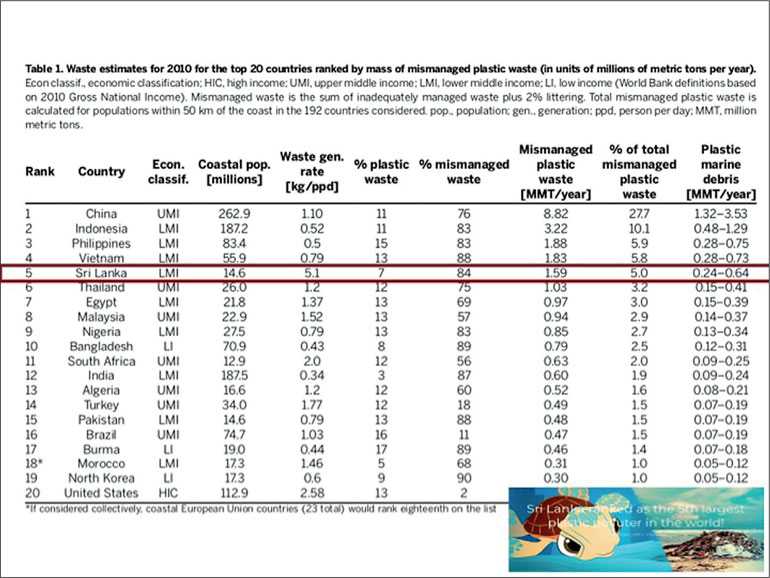
I was going through the corridors of an impressive State training facility in the heart of Colombo and witnessed the message on each floor as you await the lift that Sri Lanka is the fifth largest marine polluter with respect to single use plastics!
I also read the editorial of a prominent Sinhala daily a few days back and there too this factor minus the single use classification appeared. Editorials are supposed to be authoritative. It is important that we take due notice of real science – evidence-based data – and ensure that Sri Lanka as a nation does not get branded wrongly which can have multiple implications from tourism to investments. 
We also appeared to have taken the position as accurate and projecting the fact from our side too. Yes we appear to like global positions in whatever the manner but most of the time we can see our records to be in negative dubious territory – suicides, snake bite deaths in work places, no of holidays, per capita alcohol consumption, etc.
Sri Lanka a victim of an erroneous entry
A publication in best of science journals – Science – has also thrown us into the world-class ring with one more. The paper in the data table indicates that Sri Lanka generates 5.1 kg of waste per person per day and 7% of waste being plastics. The extent of waste mismanagement is assessed to be 84%. With the figures once placed into the spreadsheet with population data in, the order of pollution of the marine environment with plastic litter emerges. Authors have covered 192 countries. Sri Lanka appears as the fifth most polluting country in the world. This is all because of one solitary figure – 5.1 kg of waste generation per person per day. Once that figure goes into the calculation with our population and the indictment of 84% waste mismanagement the rest really is history!
While no trade, scientific or professional body raised their voice on the issue subsequent to the publication, Namini Wijedasa writing in Sunday Times on 9 July 2017 after engaging the author of the article (Dr. Jambeck) demonstrated the value of investigative journalism. Her write up was authoritative as she tracked down diligently the basis for the incorrect per capita waste generation figure used in the calculation. The data had been sourced from a World Bank publication in 2012.
The most instructive part is the final tracking down to the original articles that appear to have been the basis used by the World Bank for their publication. However, she points out that 5.1 figure is still not in any of those publications either. Though she pointed out the deficiency, the position for Sri Lanka appears to have been well consumed by the populace. 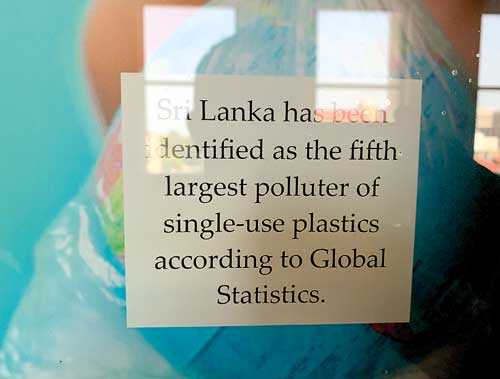
Consider the reason given by a young researcher in Australia for selecting to study the Sri Lankan issue where she having heard the fifth largest polluter position she found her call to research. Journal Science has not retracted or placed a correction for the article – Science, one must say as one of the world’s top two leading research publications, has the potential to influence anyone. Sri Lanka unfortunately has become a victim of an erroneous entry. We have been assessed thus from a population 10 times that of what we actually have!
Sri Lanka should have considered some basic facts before accepting the position. Namini, to her credit, contacted, argued and elicited a response from the principal author but failed short of a retraction and a correction in the journal. They really should have taken the country out of the assessment.
Sri Lanka’s plastic usage
We produce zero plastics in the country with all the material for plastic products being sourced from outside. Knowing the way we buy and use products and the extent of our modern trade, we know that our packaging is not excessive other than the dubious distinction in the use of lunch sheets where we are quite unique! This gives us an easy way to understand the plastic in-flow volumes and tonnages.
We also have an understanding of plastic production and consumption including that of single use plastics such as lunch sheets, straws and water bottles. There are many other plastic waste streams too. 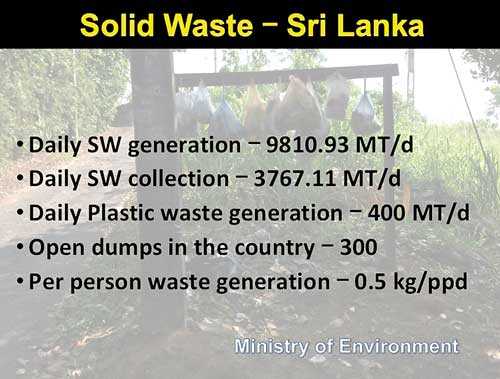
The prevailing data from Ministry of Environment indicates the following to be the waste generation picture of Sri Lanka. In the data it is seen that 400 MT per day of plastic waste generation across the country. The per person waste generation figure is indicated to be 0.5 kg/ppd. Did the authors of the Science paper place a decimal in the wrong place?! That is not expected from an author at this level for sure.
There had been significant number of waste generation assessments and it is very well known that this figure of 0.5 kg/ppd over the island is an acceptable figure. It must be indicated Sri Lanka does not engage in a national level survey like some of the developed countries, as data on garbage is also ways of understanding socio-economic changes. The project in USA – The Archaeology of Garbage, which was carried out in USA by the University of Arizona is quite instructive and demonstrate the power of understanding through garbage.
However I wish to point out another aspect. The reviewers of the article perhaps more the authors themselves should have seriously realised when one comes across a figure such as 5.1 kg of waste generation per person per day (calculated by some waste generation study and then averaging for a 21 million population) must not be quite right. The number actually stands out as an outlier and should have been recognised as such.
In solid waste management and with the science of ‘garbology’ we know that a high waste generation figure is somewhere in 1.25 kg per person per day – usually in developed countries in an urban setting. In the Science paper you can see the value of 2.5 for USA and that is the foremost throwaway economy as well as being the world’s No. 1 economy. Even in a developed country once you averaged the figures out the overall country average comes down. What I am indicating here is seen clearly in the data table in the Science paper. 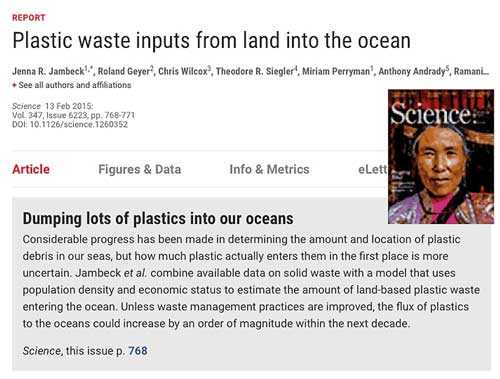
When you go through that column of per person waste generation Sri Lanka stands out. In fact we are really not the fifth largest marine polluter, we hold the world record for per person waste generation! I leave the reader to imagine the weight of garbage when they hang those garbage filled bags to the side of a lamp post or one’s boundary wall and to be mindful of the weight! The editorial slip up has caused some long-term misery to the nation. However we in some way appear to have an issue to work on with that positioning and even appears to find that attractive in some quarters – may be nice background story point for grant proposals!
Act fast
Now the title of ‘no we are not’ is not to absolve ourselves from the position of a polluter as that we do! The need for correction is in the global position. However, in this small country we have to seriously take stock of the plastics and other solid waste issues and improve our behaviour. Come Sunday we tend to burn away the accumulated plastics and our addiction to plastics such as lunch sheets, plates and cutlery, straws, etc. is evident.
Haphazard disposal of yoghurt cups have been identified to support the spread of dengue. Using plastics in eking out value from the people at the bottom of the pyramid is also a cause of concern as buddy packaging is omnipresent and who will collect those with recycling in mind? 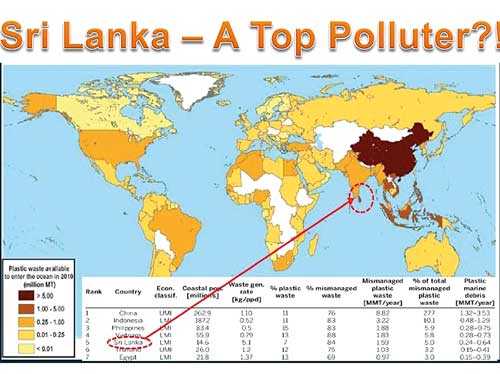
As a nation we should not be seen as one of the worst ocean polluters but we must act and act fast on ensuring that we contribute much, much less in the way we pollute at present. An island without single use plastics is not a bad goal to pursue built on responsibility imbued with inventiveness.
When you remove single use plastics from use, you are really honouring a resource for what it can do as this is a resource that can stay for over centuries and it is rather stupid to use such a resource for an activity with a few seconds or minutes in duration and then throwaway.
Discover Kapruka, the leading online shopping platform in Sri Lanka, where you can conveniently send Gifts and Flowers to your loved ones for any event including Valentine ’s Day. Explore a wide range of popular Shopping Categories on Kapruka, including Toys, Groceries, Electronics, Birthday Cakes, Fruits, Chocolates, Flower Bouquets, Clothing, Watches, Lingerie, Gift Sets and Jewellery. Also if you’re interested in selling with Kapruka, Partner Central by Kapruka is the best solution to start with. Moreover, through Kapruka Global Shop, you can also enjoy the convenience of purchasing products from renowned platforms like Amazon and eBay and have them delivered to Sri Lanka.
Discover Kapruka, the leading online shopping platform in Sri Lanka, where you can conveniently send Gifts and Flowers to your loved ones for any event including Valentine ’s Day. Explore a wide range of popular Shopping Categories on Kapruka, including Toys, Groceries, Electronics, Birthday Cakes, Fruits, Chocolates, Flower Bouquets, Clothing, Watches, Lingerie, Gift Sets and Jewellery. Also if you’re interested in selling with Kapruka, Partner Central by Kapruka is the best solution to start with. Moreover, through Kapruka Global Shop, you can also enjoy the convenience of purchasing products from renowned platforms like Amazon and eBay and have them delivered to Sri Lanka.